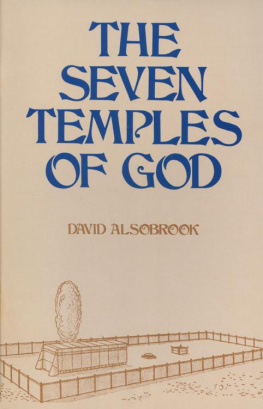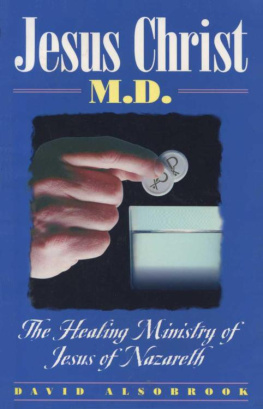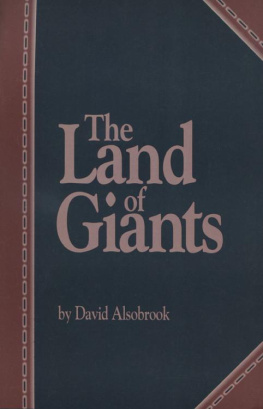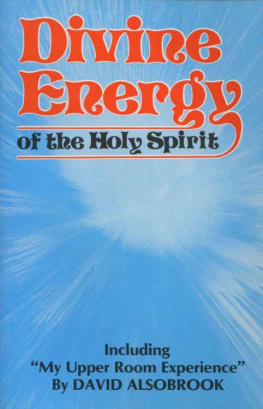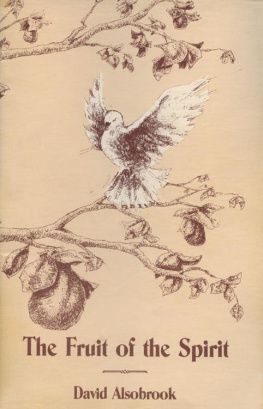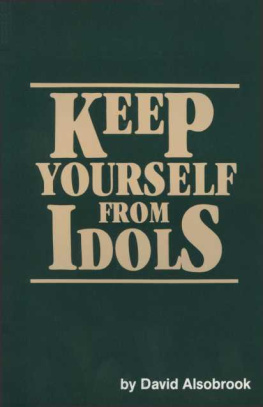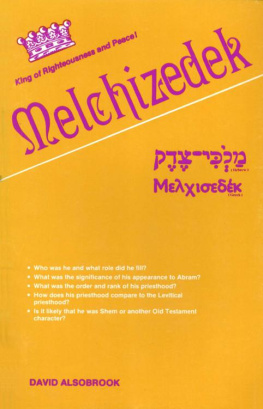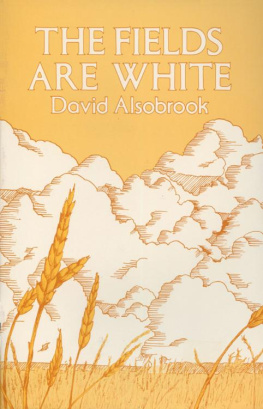David Alsobrook - The seven temples of God
Here you can read online David Alsobrook - The seven temples of God full text of the book (entire story) in english for free. Download pdf and epub, get meaning, cover and reviews about this ebook. City: Paducah, Ky, year: 1982, publisher: D. Alsobrook Evangelistic Association, genre: Religion. Description of the work, (preface) as well as reviews are available. Best literature library LitArk.com created for fans of good reading and offers a wide selection of genres:
Romance novel
Science fiction
Adventure
Detective
Science
History
Home and family
Prose
Art
Politics
Computer
Non-fiction
Religion
Business
Children
Humor
Choose a favorite category and find really read worthwhile books. Enjoy immersion in the world of imagination, feel the emotions of the characters or learn something new for yourself, make an fascinating discovery.
- Book:The seven temples of God
- Author:
- Publisher:D. Alsobrook Evangelistic Association
- Genre:
- Year:1982
- City:Paducah, Ky
- Rating:3 / 5
- Favourites:Add to favourites
- Your mark:
- 60
- 1
- 2
- 3
- 4
- 5
The seven temples of God: summary, description and annotation
We offer to read an annotation, description, summary or preface (depends on what the author of the book "The seven temples of God" wrote himself). If you haven't found the necessary information about the book — write in the comments, we will try to find it.
The seven temples of God — read online for free the complete book (whole text) full work
Below is the text of the book, divided by pages. System saving the place of the last page read, allows you to conveniently read the book "The seven temples of God" online for free, without having to search again every time where you left off. Put a bookmark, and you can go to the page where you finished reading at any time.
Font size:
Interval:
Bookmark:
THE SEVEN TEMPLES OF GOD
Contents
Introduction
I The Tabernacle or Temple of Moses
II The Tabernacle of David
III The Temple of Solomon
IV A Natural Human Body TempleIndwelt by God
V The Individual TempleThe Body of the Believer
VI The Corporate Body of Christ
VII The Seventh Temple
About the Author
"Jesus answered and said unto them, Destroy this temple, and in three days I will raise it up.... But he spake of the temple of his body" (John 2:19, 21).
Introduction
Most people think there is one or two temples listed in Scripture, but there are seven. God frequently does things in sevens.
The temple was given for a twofold purpose. The first purpose is a habitation of God's residence. Moses said, "I will prepare him an habitation" (Exod. 15:2). God had instructed Moses: "I want you to make Me a sanctuary, 'according to all that I shew thee, after the pattern of the tabernacle, and the pattern of all the instruments thereof, even so shall ye make it'" (Exod. 25:9).
Hebrews, Chapter 9, repeats that God spoke to Moses on how to build the temple. Moses was given by God, a pattern on how to build the tabernacle, or temple during the 40-days-and-40-nights period. God had said He would dwell in the temple. In all the temples recorded in the Word, God dwelt in the Holy of Holies of that temple. He dwelt there in His manifest conscious presence (in His shekina glory).
A second purpose of the temple is to serve as a facility in which worship is offered unto God.
The first temple was merely a tabernacle. A tabernacle serves the same purpose as a temple, but is a tent rather than a building. God spoke to Moses, "Let them [meaning Israel] make me [God] a sanctuary," indicating a PLACE of residence, a refuge, a hallowed, holy place where God would dwell.
Let us take a bird's eye view of the seven temples.
I
The Tabernacle or Temple of Moses
The first temple, or tabernacle, was the tabernacle of Moses. It was erected and carried across the wilderness for forty years into Canaan land, and was finally pitched on Mount Gibeon. It stayed there for hundreds of years.
The structure: a mobile tent
The specific truth portrayed: the law of God.
While receiving instruction to build the tabernacle, Moses basked in the presence of God on Mount Sinai.
When he came down from that mount, the children of Israel asked that they might not see his face because of the glory that was upon him. They turned from THE LAW THAT HAD GLORY. In fact, it was a fading glory, and that is why Moses would often go into the tent in order that the glory would again come upon him (see 2 Cor. 3:7-14).
Moses himself said, "I exceedingly fear and quake" at the revelation of God's law (Hebrews 12:21). It wasn't a joyful, jubilant time, it was a very solemn, sober assembly at the institution of the tabernacle of Moses. There were no musical instruments, no joyful shouts of praise offered to God, and all who went to the tabernacle in the wilderness approached it in holy fear, and even dread.
The institution of this temple brought forth the law, which symbolizes the righteousness of God, His almighty omniscient holiness, and no one could approach Him unless he met His requirements found in the law.
This is why the high priest would approach Him in fear of death. He literally trembled as he entered into the holy of holies, for he knew he had to fulfill the exact procedures or he would die (Lev. 16:2).
This first tabernacle was a beginning place of worship, and sacrifices of blood offerings were offered to God. It was a solemn type of worship, and apparently not much joy or jubilation was present. Note the progression in the second tabernacle.
II
The Tabernacle of David
Four hundred years after the institution of Moses' tabernacle, the Lord put it into David's heart to move the ark of God from Gibeon to the city of David, "and set the ark of God" (2 Sam. 6:1-10), the second tabernacle.
The only thing that David took out of the tabernacle of Moses was the ark of God (2 Chronicles 1:4), and put it upon a new cart and brought it from Kirjath-jearim. Uzzah stretched forth his hand to steady the ark, and God smote him and he died. This displeased David very greatly, and he left the ark of God at the house of Obed-edom. He didn't want any more Israelites dying, so he left the ark with the Gittite. For three months the Lord blessed the house of Obed-edom (see 2 Samuel 6:1-12).
David heard that the ark of the Lord was causing great blessing, and he went to the house of Obed-edom and got the ark of the covenant.
This time when he brings it he has had a change of heart. He no longer approached it with fear and dread, even though Uzzah had been killed. Now he approached the ark of the covenant with great jubilation, and as he carried that ark he did something which was not lawful. A king, or prophet, or an Israelite could not do the work of the priest (Numbers 3:38). If anyone other than an anointed priest tried to do the work of the priest he would be put to death.
An example of this is shown in 2 Chronicles 26:16 when King Uzziah went into the temple and offered incense.
When he did this he was smitten with leprosy, and later died.
David was now acting on revelation, and stripped his kingly garments, donning the priestly ephod. Some mistakenly say that David was naked. However, he was clothed with the priestly ephod and so was covered, but he was stripped in the sense that his kingly garments were laid aside.
Here was a king that looked like a priest! If he had not had a revelation of grace he would have been struck dead.
Notice in the account in 2 Samuel, Chapter 6, that they would go six paces then offer sacrifices. David danced before the Lord with all his might; girded with a linen ephod. "With shouting and with the sound of the trumpet" (vs 14-15) he brought the ark of the Lord into the city of David.
Observe the establishment of David's tabernacle: "And they brought in the ark of the Lord, and set it in his place, in the midst of the tabernacle that David had pitched for it" (2 Sam. 6:17). Tabernacle here means tent.
David didn't even have an outer court, or a holy place. He merely had a little tent to serve as the holy of holies. He didn't have all the furniture that was supposed to be in the original temple that God showed Moses.
All David had was the ark of the covenant which he placed in the tent that he pitched on Mount Zion. There was no veil separating the ark from the people. The ark represented the presence of God. In the first tabernacle God dwelt between the two cherubim that were over and above the ark, right above the mercy seat sitting atop the ark. Here the people worshipped God.
At the coronation of this second temple (see 1 Chron. 15:1-29) there was praise, worship, dancing, clapping, lifting of holy hands and musical instruments. It was a very joyous occasion. David offered burnt offerings and peace offerings to the Lord and blessed the people in the name of the Lord of hosts (v. 18). David gave everyone wine, meat and bread. Meat and bread symbolize the WORDJesus; and the flagon of winethe joy of the Holy Ghost. It was a very happy occasion, even though Michal, Saul's daughter and David's wife, despised David in her heart for his actions.
The specific truth portrayed: The tabernacle of David was a revelation of GRACE.
There was no way that God's people could worship Him acceptablyafter all, they had transgressed His commandment, broken His law, and it was impossible for man to keep the law. Yet, here they were, worshiping God as though they were righteous. They were seeing the work of GRACE.
David was chosen to show forth that grace, which was a foreshadowing of grace of the New Testament, because from him would come the seed Who would actually bring it into being. For the law was given by Moses, but grace and truth came by Jesus Christ" (John 1:17). The king's revelation of GRACE so pleased God that He said centuries later that He would raise again the tabernacle of David.
Next pageFont size:
Interval:
Bookmark:
Similar books «The seven temples of God»
Look at similar books to The seven temples of God. We have selected literature similar in name and meaning in the hope of providing readers with more options to find new, interesting, not yet read works.
Discussion, reviews of the book The seven temples of God and just readers' own opinions. Leave your comments, write what you think about the work, its meaning or the main characters. Specify what exactly you liked and what you didn't like, and why you think so.

